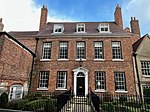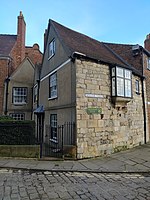York St John University

York St John University (originally established as York Diocesan College), often abbreviated to YSJ, is a public university located on a large urban campus in York, England. Established in 1841, it achieved university status in 2006 and in 2015 the university was given research degree awarding powers for PhD and doctoral programmes.It is one of several higher education institutions which have religious foundations and is part of the Cathedrals Group of Universities.In 2022, there were 8,350 students, reading a wide variety of subjects, across five schools: School of the Arts; School of Education, Language and Psychology; School of Humanities; School of Science, Technology and Health; and York Business School.
Excerpt from the Wikipedia article York St John University (License: CC BY-SA 3.0, Authors, Images).York St John University
Lord Mayors Walk, York Layerthorpe
Geographical coordinates (GPS) Address Nearby Places Show on map
Geographical coordinates (GPS)
| Latitude | Longitude |
|---|---|
| N 53.965402 ° | E -1.080673 ° |
Address
Quad
Lord Mayors Walk
YO31 7EX York, Layerthorpe
England, United Kingdom
Open on Google Maps











